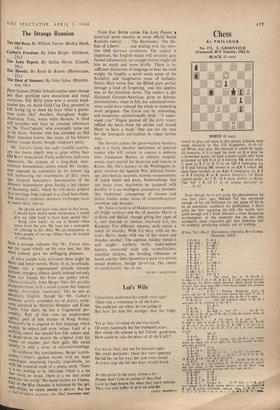Chess
By PHILIDOR No. 172. C. GROENVELD (Commend, BCF Tourney, 1962-3)
BLACK (8 men)
WHITE (8 men)
WHITE to play and mate in two moves; solution next week. Solution to No. 171 (Lapierre): 0 0 01
(a) White may play this because it could be legal;
(b) however, if it is legal his rook on Q 4 must be a promoted pawn; (c) such a pawn could only have promoted on KB 8 or Q 8 (forcing BK move when it went to B 7 or Q 7) or on QB 8 (emerging via Q 8 and forcing BK move) or on KR 8 (when BR must have moved) or on KKt 8 (emerging via B 8 or R 8 forcing R or K move): therefore. td) Black cannot castle! So 2 R—Q 8 mate. Unfair to Black. The 'try' 1 R—Q 1? is of course defeated by 1 . . . 0--01 Even though he is not quite the phenomenon he was four years ago, Mikhail Tal has recovered enough of his old brilliance for any game of his to be an automatic candidate for publication. I don't quite see him regaining the title (his health isn't good enough and I think Smyslov a more dangerous ex-champion at the moment) but he has this wonderful chess conjurer's gift that Alekhine had of suddenly producing attacks out of nothing.
White, TA[.; Black. MATANOVIC; Opening, RUY LOPEZ. (Moscow, 1963) 1 P—K 4 P—K 4
2 Kt—KB 3 Kt —QB 3 3 B—Kt 5 P—QR 3 4 B—R 4 Kt—B3 5 0-0 B—K 2 6 R—K I P—QKt 4 7 B—Kt 3 P—Q 3 8 P—B 3 0-0 9 P—.KR 3 Kt—QR 4 10 B—B 2 P—B 4 11 P—Q 4 Q—B 2 12 QKt—Q 2 B—Q 2
13 Kt—B1 KR—KI 14 P—QKt 3 . The usual line is 14 Kt—K 3, P—KKt 3; 15 P xP, Px•P; 16 Kt—R 2 with long-term attack- ing chances for White which, however, Black should be able to hold. Text takes away QB 5 from Black knight and prepares for B—K 3 and R—QB 1.
14 . . P—Kt 3. Perhaps Matanovic failed to notice that Kt—K 3 had not been played this time! P—Kt 3 is better delayed until White cannot play B—Kt 5 io reply. 15 B—Kt 5 . . with the awkward threat of Kt.—K 3 and later BxKt followed by Kt—Q 5.
15 Kt- -R 4
16 BxB R >,B
17 Kt—K 3 Kt—KB 3. Not 17. . Kt—B 5?;
18 P—Kt 3!, Kt XP oh; 19 K—Kt 2 with the 'double threat of Kt—Q 5 and R—R 1.
18 Kt—Kt 5! . — A. Tel move. If in reply 18 . P—KR 3: then 19 Q—B 3!, K—Xt 2; 20 QxKt oh!, KXQ: 2l Kt—Q 5 eh, KxKt; 22 KtXQ, R—QB 1; 23 Kt—Q 5, R—K 1; 24 P—R 4 ch!, K XP; 25 P—Kt 3 ch with winning attack! BPxP 15 R—B 1
19 1P 20 R—QB l P—R 3? Seeing that 0—B 3 no longer works he thinks this is all right—but Tal has another remark- ableitidpeax pavailable.
P x P 22 Kt—Q 5! KtxKt 23 PxKt Kt—Kt 27 23 ... 0—Kt 3 is necessary. ;4 KtxPl RKt 24 ..KxKt?; 25 B>.P eh, Kx13;
26 RxQ, R xR; 27 Px—Q 6! and. wins.
25 ExP Q—Q 3. Or 25. . QXR; 26 BXR eh, Kx13; 27 Q—R 5 eh followed by 28 'RXQ and the queen will win owing to the exposed position of the Black king and his uncoordinated position and his week pawns.
26 B xRch BKxxRB
27 R xR 25 Q—B 2! B—Q 2 29 Q—R 7 ch K—B 1
30 R—K 3 Resigns 30 . . Q>l); loses to R r2 3 and without QxP Black cannot defend against the threatener(
R and Q attack—immediate menace heing 31 R—B 3 ch.
K 1. 12 0 Et 1," k: 2. 13 Q-41 8 'or R-13.7 matt!.


































 Previous page
Previous page